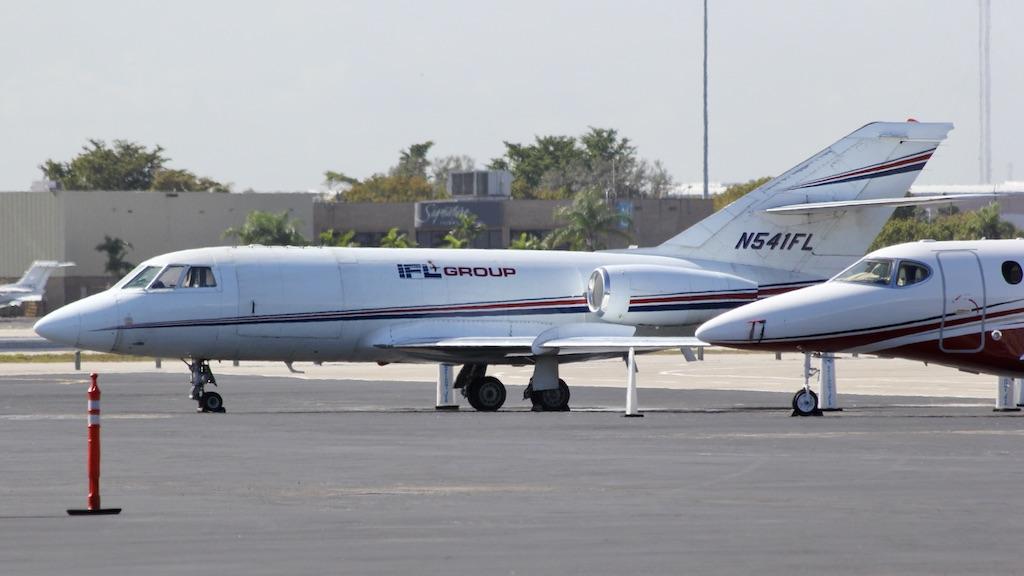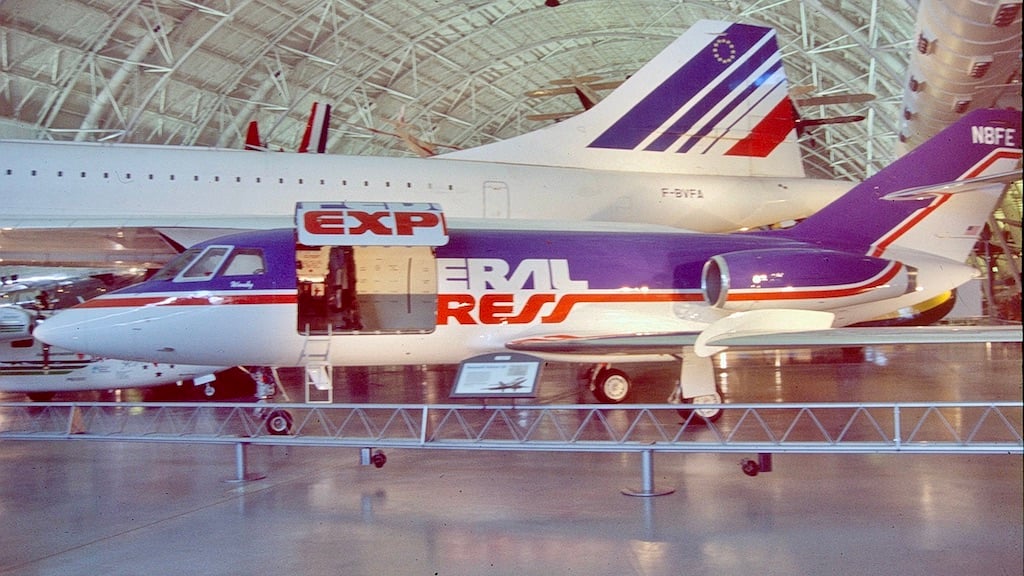
Inspired by the French Mystère fighter-bomber, the Falcon 20 entered production in 1965.
Originally known as the Mystère 20 after the 1950s fighter-bomber named Mystère, the Falcon 20 was Dassault’s first business jet.
The prototype Mystère 20 first flew on May 4, 1963, with production starting in 1965. It was designed as a low-wing monoplane with swept, full-cantilver wing, cruciform tail, retractable tricycle landing gear, and rear-mounted General Electric CF700-2C turbofans, each producing 4,125 lb. of thrust.
The production jet seated up to 10 passengers, cruised up to Mach 0.8, and flew to a range of 1,080 nm. Its factory-new, average equipped list price in 1965 was $1.29 million, according to the Aircraft Bluebook.
Dassault initially intended the Falcon 20 for European travel, but the prospect of entering the U.S. market as a contemporary of the Learjet 23, Hawker-Siddeley 125 and North American Sabreliner “led designers to stretch the wings,” in order to extend its range, the manufacturer says. Chairman and CEO Serge Dassault headed the company’s delegation to the 1962 NBAA conference in Pittsburgh to test the waters.
“The Falcon 20 wowed some of the top aviation leaders of the time, including Charles Lindbergh, Pan Am chief executive Juan Trippe, and FedEx founder Fred Smith,” Dassault recalled in May 2023, the occasion of the jet’s 60th anniversary.
“It went on to spawn 27 different model types that found eager buyers among entrepreneurs, government agencies and several nations’ armed forces,” the manufacturer said. “Its pioneering safety features, including the use of rugged fighter structures and systems, set the standard for countless future safety improvements, from head-up cockpit displays to digital flight controls—technology that subsequently became widespread across the industry.”
A Business Catalyst

A pioneer in its own right, the Falcon 20 was a catalyst for other new starts. Lindbergh inspected the prototype at Dassault’s Mérignac final assembly plant near Bordeaux, France, on behalf of the Pan Am board, which then ordered 40 of the jets based on his recommendation. Pan Am Business Jets, the airline’s new executive jet division, eventually became Dassault Falcon Jet at Teterboro Airport, New Jersey.
FedEx founder Frederick Smith selected the Falcon 20 to move express packages by air, creating a new category of airline. Between 1972-74, FedEx built a transportation network using 33 of the Dassault jets, which were modified with a forward cargo door.
In 1977, the U.S. Transportation Department signed a contract to acquire 41 Falcon Gs for the U.S. Coast Guard, replacing the GE CF700 engines with Garrett ATF3-6 turbofans. “Dassault Aviation had managed to penetrate the ultra-closed U.S. market in spite of the Buy American Act,” said the manufacturer.
Dassault Falcon Jet in Little Rock, Arkansas, performed completions of the Coast Guard jet, designated the HU-25 Guardian, for the medium-range maritime surveillance role. Deliveries took place from February 1982 to December 1983. By 2014, the Coast Guard phased out its HU-25s, replacing them with the HC-144A Ocean Sentry, a twin-engine turboprop.
A Falcon 20 operated by the National Research Council of Canada in October 2012 became the world’s first civil jet to fly on 100% biofuel. During a one-hour test flight over Ottawa, the jet’s CF700-2D2 turbofans burned ReadiJet, an unblended biofuel made from oilseed crops.
Dash 5 Modification

Dassault introduced the Falcon 20-5, re-engined with higher-thrust Garrett (Allied Signal) TFE731 turbofans to improve the jet’s range and performance, under a service bulletin. Garrett (which ultimately morphed into Honeywell) started a re-engining program in the mid-1980s to replace the Falcon 20’s original GE engines with 4,750-lb.-thrust TFE731-5BR turbofans, nearly doubling its range at the time to 2,450 nm.
Re-engined Falcon 20-5s are Stage 3 noise-compliant, meeting an FAA mandate that aircraft weighing 75,000 lb. or less meet that standard by 2015 to operate in the contiguous U.S.
The final Falcon 20 variant, which was produced until 1983, was the Falcon 20F. Powered by 4,500-lb.-thrust GE CF700-2D-2 engines, it featured a redesigned wing that improved takeoff and landing performance and increased fuel capacity.
The factory-new, average-equipped list price of the 20F in 1973 was $2.15 million; its current average retail price—the average price for a midtime, average aircraft at the end of the previous quarter—is $300,000, according to the Aircraft Bluebook.
Dassault then produced the follow-on Falcon 200, which shared the same fuselage as its predecessor but came with more powerful (5,200-lb.-thrust) Garrett ATF3-6A-4C engines. The factory-new, average equipped list price of the jet in 1983 was $7.8 million; its current average retail price is $600,000, the Aircraft Bluebook says.
Over a nearly quarter-century production run, Dassault built 477 Falcon 20 variants and 38 Falcon 200s. About one-fifth of those 515 aircraft remain in service. Aviation Week’s Fleet Discovery Database in March counted 30 Falcon 20s, 46 Falcon 20-5s, 23 Falcon 20Fs, and 12 Falcon 200s.
BCA welcomes comment and insight from aircraft dealers and brokers for its monthly 20/Twenty pre-owned aircraft market feature. The focus aircraft for April is the Beechjet 400A, and for May, the Pilatus PC-24. To participate, contact [email protected].





